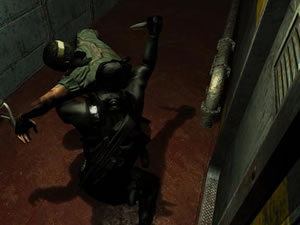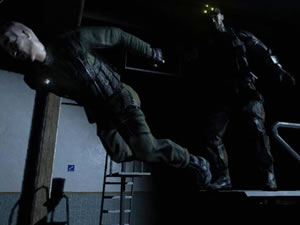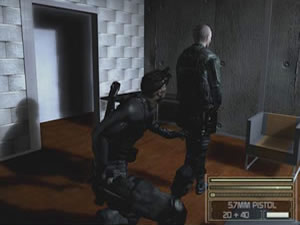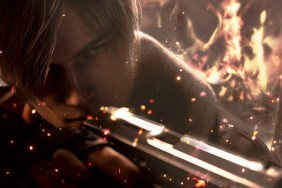The spy who fragged me.
When it was announced that a new, revolutionary Splinter Cell was going to be released approximately a year after its sequel, we were very skeptical. A year is usually just enough time to build some new levels, throw in some new dialogue and release basically the same game with a fancy, hip subtitle. From all the hype and advance demos, we expected a completely revamped single-player game plus a nifty little co-op feature. So when we discovered that the single-player game was more refined than revolutionary, we were a little crestfallen.
And then we played…and played…and played. We got sucked into interacting with the incredible environments as Sam Fisher and losing ourselves coordinating co-operative ambushes. While the controls took a lot of getting used to and the graphics weren’t nearly as good as what we saw on the PC and Xbox, we were still relatively pleased with the Gamecube version of Splinter Cell: Chaos Theory.
When the game begins, ace sneak Sam Fisher is called on to investigate the kidnapping of a mathematician by a group of Peruvian rebels. After breaking several backs and hacking into scores of computers, Sam spies his way into the middle of a potentially earth-shattering conflict between Japan, China, and both Koreas.
The source of the trouble is the I-SDF, a Japanese version of the CIA. North Korea and China claim that the existence of this agency violates international law, while Japan claims that I-SDF research has proven that North Korea and China have been conspiring to disrupt Japan’s economy. Both sides are being manipulated by shadowy characters who seek to profit from a huge conflict, and these men are your targets. Be afraid, Colonel Sanders, be very afraid.
International quagmires involving information warfare and corrupt constitutions may interest academics and politicians, but when it comes to video games, such things always boil down to "The world is about to end, and only you can save it." Throughout the course of the game, the threat of World War III is milked repeatedly in an attempt to add drama and urgency to your missions. This scenario has become a dramatic crutch for the series. In the first game it was cool that this unknown spy was all that stood between peace and war, but we’ve all sort of gotten over it. Just blow up the damn world, Ubisoft, and let us get our post-apocalyptic espionage on.
Even though the overarching story is dry and none of the characters are particularly interesting, the dialogue is well-written and funny. By now you’ve probably forgotten what the Masse kernels even are, but the fear and dread that creep into Anna Grimsdottir’s voice when they’re mentioned tells you all you need to know.
Ultimately, Chaos Theory‘s story is just an excuse for you to explore and gather reconnaissance in several diverse and perilous locales. Every environment has been brilliantly crafted to create the illusion of open-endedness, and all are full of obstacles, from rough mercenaries to squeaking, ninja-proof floors. Instead of placing you in open, labyrinthine levels, Chaos Theory provides you with several, intertwining avenues. You might choose to make your way down a hallway taking out lights, guards and cameras as you go, or sneak through a crawl-space and drop into an office. Both means will take you to the same end, so you’ll never get lost. Chaos Theory‘s blend of alternate routes and linear progression ensures that you will always have a choice and never feel as though you’re simply being pushed from one corridor to the next.
 The intricacies of each level are compounded by the plethora of tools and abilities at Sam’s disposal. There are a couple new additions, including an electro-magnetic scrambler pistol attachment that can temporarily disable electrical devices. It kicks ass, providing yet another way to bypass sticky situations and adding to Sam’s nightmarish mystique. Imagine from a bad guy’s point of view mysteriously having the lights flicker off for a moment, only to turn back on to reveal your partner stabbed to death.
The intricacies of each level are compounded by the plethora of tools and abilities at Sam’s disposal. There are a couple new additions, including an electro-magnetic scrambler pistol attachment that can temporarily disable electrical devices. It kicks ass, providing yet another way to bypass sticky situations and adding to Sam’s nightmarish mystique. Imagine from a bad guy’s point of view mysteriously having the lights flicker off for a moment, only to turn back on to reveal your partner stabbed to death.
Speaking of which, Sam also has a new combat knife he can use to slice through any fabrics or enemies he comes across. Some might find the knife a little bit too easy to use, but we respect it as a means of making the game a little more accessible. The beauty of Splinter Cell has always been how it allows the player to make the game as hard or easy as desired depending on their approach to a situation. The knife definitely provides a new approach.
After trying to figure out Chaos Theory‘s wacky control scheme, the easy approach will probably seem very appealing, since the Gamecube controller lacks several of the buttons used in the other versions. As a result, you’ll have to press the Z button plus different directions on the D-pad and the C-stick to do things like access your inventory, zoom in, and open your OPSAT. The game is still playable, and over time you’ll memorize all the various commands, but this certainly isn’t a game you can just pick up and play.
Apart from the scrambler and knife, Sam relies on all the same gadgets and most of the same moves that he used in the original Splinter Cell. Before missions, you are given three different equipment options: stealth (few bullets and lots of gadgets), assault (all guns and grenades), and Redding’s Recommendation (stealth with more bullets and fewer sticky cams). This is an improvement over the system used in previous games, but simply allowing players to customize their own equipment would have made a lot more sense.
The combination of Sam’s myriad capabilities and the dynamic levels makes Chaos Theory an incredibly malleable game. If you’re feeling impatient, you can go for an assault loadout and assassinate everyone you come across. If you’re in a more easygoing mood, you can explore levels to see what secrets they hide, or if you want to go hardcore you can attempt to navigate without attacking any soldiers or ever getting spotted. No matter how you play, the difficulty really ramps up in the latter half of the game. This is clutch, because if you’ve played the other games you’ll breeze through most of the early and middle levels.
Also, a new quick save feature available across the board will spare you a lot of time and effort. Trial and error gameplay used to plague this series, but the quick save allows you to easily save at any point, and then try all the different approaches you can think of without having to play back through anything unsavory.
 Even though Chaos Theory provides a fairly deep campaign, it isn’t nearly as ambitious as we hoped it would be. Instead of taking the series in a new direction or adding a major new twist, Chaos Theory’s single-player mode is more of the same. While we can hardly blame Ubisoft for not wanting to take chances with their most successful franchise, Chaos Theory‘s similarity to its predecessors can really curb your enthusiasm; you’ve probably already seen much of what the Story mode has to offer.
Even though Chaos Theory provides a fairly deep campaign, it isn’t nearly as ambitious as we hoped it would be. Instead of taking the series in a new direction or adding a major new twist, Chaos Theory’s single-player mode is more of the same. While we can hardly blame Ubisoft for not wanting to take chances with their most successful franchise, Chaos Theory‘s similarity to its predecessors can really curb your enthusiasm; you’ve probably already seen much of what the Story mode has to offer.
We’re sure that you haven’t seen the co-op, though. While it only contains four levels worth of content, co-operative play is a major new element that introduces some cool new moves. Your spies can boost each other up to high places, climb each other, hurl each other over laser grids, and rappel down steep surfaces. If injured or knocked-out, spies can heal each other with a miraculously beneficial adrenaline shot. Ouch.
Sadly, the Gamecube version lacks the Spy vs. Merc mode found in the other verrions, easily keeping it at the bottom of the pack. In an effort to make up for it, the game does have a GBA connectivity feature. You can jack your GBA into your Gamecube and issue certain commands from there instead of awkwardly pressing Z+Start. You can also fire a sticky camera and monitor it through your GBA while doing other things as Sam. This is a pretty nifty little feature, but makes us wonder: what about the DS?
Graphically, the Gamecube version is pretty solid. The lighting isn’t as sophisticated as what you’ll find on the PC or Xbox versions, but the animations are still smooth and overall things look pretty good. They don’t sound bad, either. The ambient effects are varied and clear, the voice acting is superb, and the score, composed by Amon Tobin, is hip and catchy but also understated and mysterious – perfect for a Splinter Cell.
While Splinter Cell: Chaos Theory doesn’t deliver a terribly original single-player experience, it introduces a useful new co-operative mode. Though the Gamecube version of Chaos Theory suffers from tricky control and is missing online play, it’s still an involved, mature game. If you’re a Gamecube owner who likes hardcore games, this is a title you shouldn’t let out of your sight.











